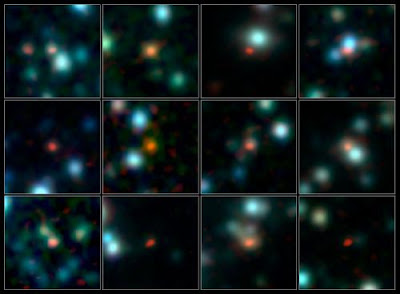Whereas the APEX images were not sharp enough to identify the emitting galaxies unambiguously the much sharper ALMA images can pin down the emitting galaxies much more precisely.
The ALMA and APEX observations, at submillimetre wavelengths, are overlaid on an infrared view of the region as seen by the IRAC camera on the Spitzer Space Telescope (coloured blue).
Credit: ALMA (ESO/NAOJ/NRAO), APEX (MPIfR/ESO/OSO), J. Hodge et al., A. Weiss et al., NASA Spitzer Science Center.
A team of astronomers has used ALMA (the Atacama Large Millimeter/submillimeter Array) to pinpoint the locations of over 100 of the most fertile star-forming galaxies in the early Universe.
This image shows close-ups of a selection of these galaxies.
The ALMA observations, at submillimetre wavelengths, are shown in orange/red and are overlaid on an infrared view of the region as seen by the IRAC camera on the Spitzer Space Telescope.
The best map so far of these distant dusty galaxies was made using the Atacama Pathfinder Experiment (APEX), but the observations were not sharp enough to unambiguously identify these galaxies in images at other wavelengths.
ALMA needed just two minutes per galaxy to pinpoint each one within a comparatively tiny region 200 times smaller than the broad APEX blobs, and with three times the sensitivity.
Credit: ALMA (ESO/NAOJ/NRAO), APEX (MPIfR/ESO/OSO), J. Hodge et al., A. Weiss et al., NASA Spitzer Science Center
A team of astronomers has used the new ALMA (Atacama Large Millimeter/submillimeter Array) telescope to pinpoint the locations of over 100 of the most fertile star-forming galaxies in the early Universe.
ALMA is so powerful that, in just a few hours, it captured as many observations of these galaxies as have been made by all similar telescopes worldwide over a span of more than a decade.
The most fertile bursts of star birth in the early Universe took place in distant galaxies containing lots of cosmic dust.
These galaxies are of key importance to our understanding of galaxy formation and evolution over the history of the Universe, but the dust obscures them and makes them difficult to identify with visible-light telescopes.
To pick them out, astronomers must use telescopes that observe light at longer wavelengths, around one millimetre, such as ALMA.
 |
| Jacqueline Hodge |
The best map so far of these distant dusty galaxies was made using the ESO-operated Atacama Pathfinder Experiment telescope (APEX).
It surveyed a patch of the sky about the size of the full Moon, and detected 126 such galaxies but, in the APEX images, each burst of star formation appeared as a relatively fuzzy blob, which may be so broad that it covered more than one galaxy in sharper images made at other wavelengths.
Without knowing exactly which of the galaxies are forming the stars, astronomers were hampered in their study of star formation in the early Universe.







No comments:
Post a Comment